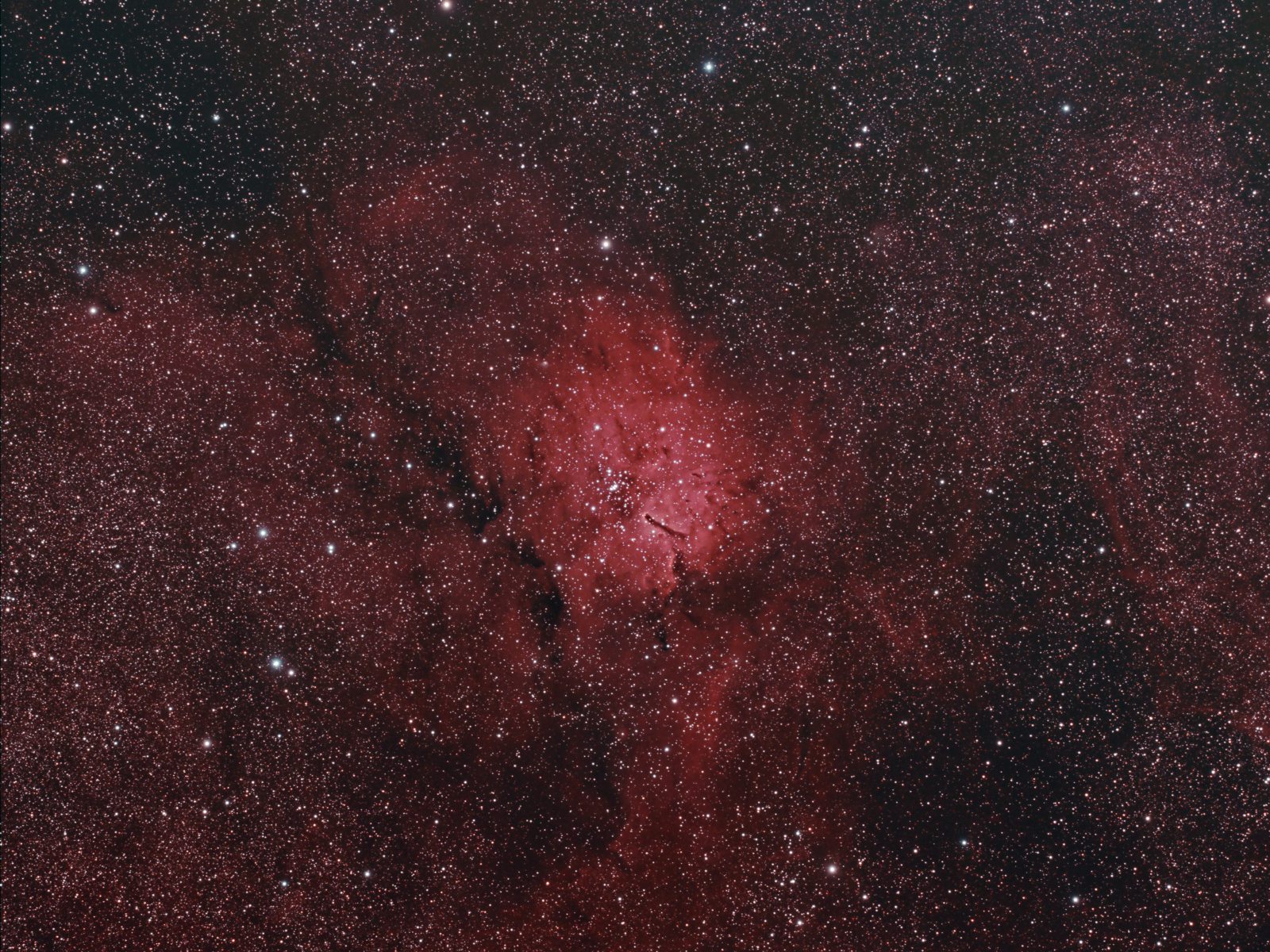Sharpless 2-86
 Click image for full size version
Click image for full size version
September 1, 2019; Back Cover of Journal of the Royal Astronomical Society of Canada, December 2019
 This image shows emission nebula Sharpless 2-86 (aka Sh2-86 and NGC 6820), a large emission in Vulpecula (the Little Fox). The roundish central nebula is about the size of the full moon on the sky. The star cluster in the middle of the nebula is NGC 6823, and the stars at its centre are around 2 million years old, but the outer cluster stars are likely younger. The dark finger-like structure near centre is thought to be caused by erosion in the nebula’s gas and dust caused by radiation from nearby stars. There are similar structures in the Eagle Nebula, sometimes called “The Pillars of Creation.” To give a sense of scale to this image, the open cluster is about 50 light years across, and both cluster and nebula are about 6,000 light years away.
This image shows emission nebula Sharpless 2-86 (aka Sh2-86 and NGC 6820), a large emission in Vulpecula (the Little Fox). The roundish central nebula is about the size of the full moon on the sky. The star cluster in the middle of the nebula is NGC 6823, and the stars at its centre are around 2 million years old, but the outer cluster stars are likely younger. The dark finger-like structure near centre is thought to be caused by erosion in the nebula’s gas and dust caused by radiation from nearby stars. There are similar structures in the Eagle Nebula, sometimes called “The Pillars of Creation.” To give a sense of scale to this image, the open cluster is about 50 light years across, and both cluster and nebula are about 6,000 light years away.
Tekkies:
Takahashi FSQ-106 ED IV @ f/3.6, QHY367C one-shot colour camera, and Optolong L-eNhance narrowband filter, Paramount MX, unguided. Acquisition, and focusing with TheSkyX. Focus with Optec DirectSync focus motor and controller. Automation with CCDCommander. Equipment control with PrimaLuce Labs Eagle 3 Pro computer. All pre-processing and processing in PixInsight. Acquired from my SkyShed in Guelph. Waning crescent Moon, average to above average transparency and fair to average seeing. Data acquired August 5-10, 2019.
118x10m with Optolong L-eNhance filter (Total = 19hr40m)
Image scale 2.59 arcsec per pixel
Data Reduction and Cleanup
Preprocessing: The BatchPreProcessing script was used to perform calibration, debayering, and registration of all frames. ImageIntegration followed by DrizzleIntegration with the CFA Drizzle option was used to make the master, which was then cropped.
Gradient Removal: Gradient removal was not necessary.
Channel Registration: To improve channel registration, the RGB colour channels were extracted and aligned with ImageIntegration, using 2D Surface Splines with Distortion Correction and the Green channel as the reference frame. The registered colour channels were recombined with RGBCombination.
Luminance Extraction: RGBWorkingSpace was applied to normalize the channels, and the Luminance was extracted for separate processing as described below.
Colour
Colour Balancing: The colour image was colour balanced with ColorCalibration (note; this did not correct star colours, since this image used a narrowband filter)
Linear Noise Reduction: MultiscaleLinearTransform was used to reduce noise in the background areas, using an internal mask to protect bright structures. Layer settings for threshold and strength: Layer 1: 5.0 0.75 Layer 2: 3.0, 0.70 Layer 3: 2.0, 0.6 Layer 4: 1.0, 0.2.
Stretching: HistogramTransformation was applied to make a pleasing, bright image, with background set to an intensity of approximately 0.10.
Luminance
Deconvolution: StarMask was applied with default settings to produce a Local Deringing Support Image. A clone of the image was stretched to use as a deconvolution mask. Deconvolution was applied (80 iterations, regularized Richardson-Lucy, external PSF made using PSFImage script with about 50 stars).
Linear Noise Reduction: MultiscaleLinearTransform was used to reduce noise in the background areas, using an internal mask to protect bright structures. Layer settings for threshold and strength: Layer 1: 3.0 0.9 Layer 2: 2.0, 0.75 Layer 3: 1.0, 0.6 Layer 4: 0.5, 0.2.
Stretching: HistogramTransformation was applied to make a pleasing, bright image, with background set to an intensity of approximately 0.10.
Recombining Luminance and RGB
LRGB Combination: The luminance image was applied to the RGB image using LRGBCombine with default settings.
Additional Processing
Nonlinear Noise Reduction: TGVDenoise was used in L*a*b* mode to reduce noise with a mask used to target the background areas and protect the stars (max. 1000 iterations and convergence selected for both lightness and chrominance).
Dynamic Range Compression: HDRMultiscaleTransformation was applied with 6 layers and default settings. The result was blended into the original imge 1:1, using a mask to limit application to bright areas of the nebula. LocalHistogramEqualization was applied twice (scales 50 with strength 0.42, followed by scale 150 with strength 0.2) using the same mask.
Sharpening: MultiscaleLinearTransform targeting the lightness channel was used to sharpen Layers 2 and 3, each with a strength of 0.07. A mask was used to limit sharpening to the brightest regions of the nebula.
Final Steps: Background, nebula and star brightness, contrast, hue and colour saturation were adjusted in several iterations using CurvesTransformation with masks as required. The DarkStructureEnhance script was applied with a strength of 0.3 and 8 layers. The image scale was returned to the native scale of the camera/telescope using IntegerResample to downsample by a factor 2.






Leave A Comment